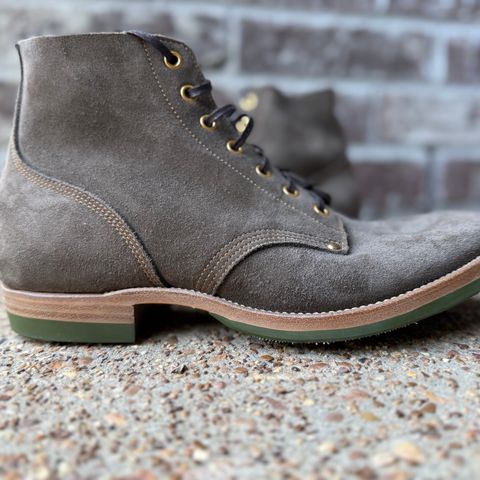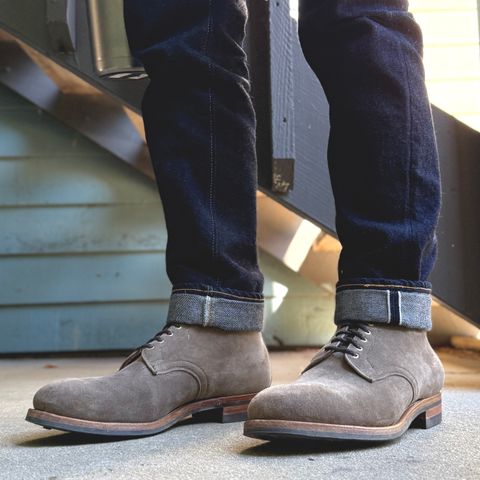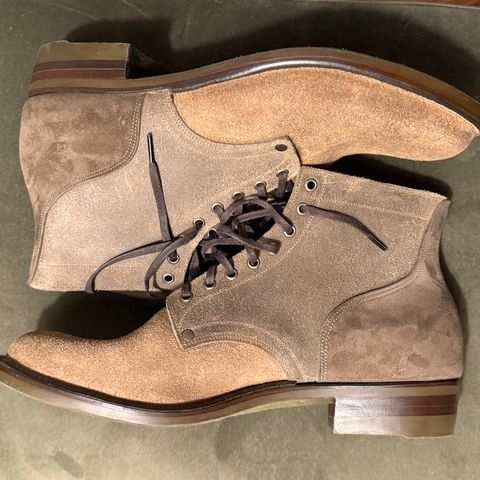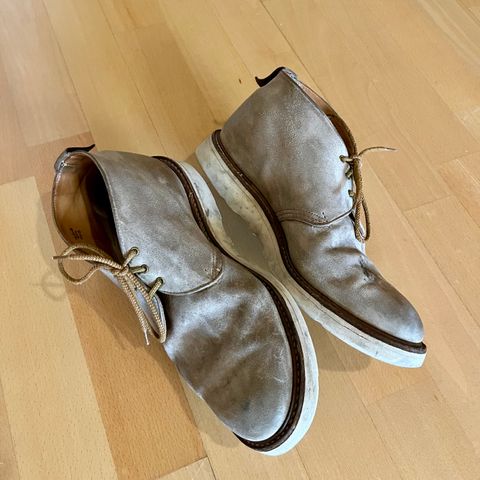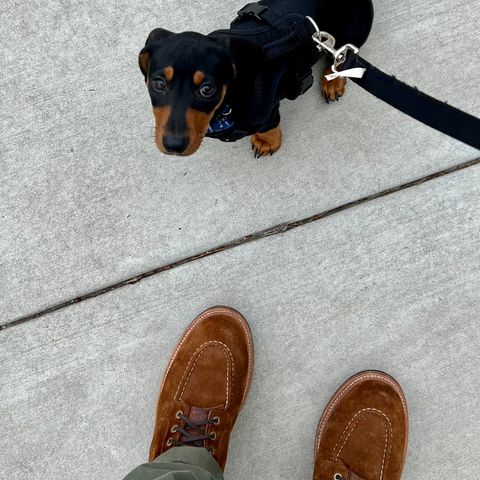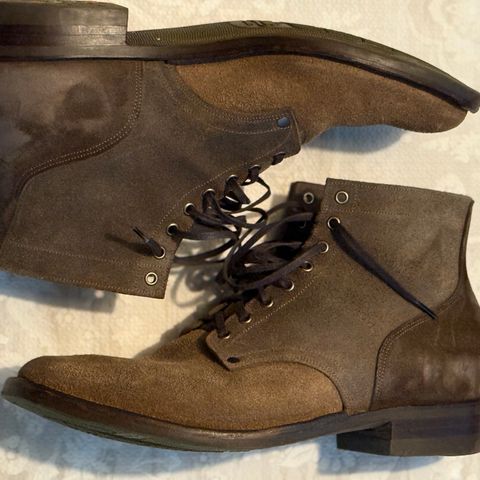About
Kudu Reverse is a distinctive suede leather featuring a luxuriously soft reverse side and nubuck finish on the grain side, produced by Charles F. Stead through their specialized Janus tannage process. The leather is crafted from antelope skins sourced from South Africa through controlled seasonal culling programs, with each hide measuring 13-15 square feet and exhibiting unique natural markings from the animal's life in the wild.
About
Kudu Reverse is a distinctive suede leather featuring a luxuriously soft reverse side and nubuck finish on the grain side, produced by Charles F. Stead through their specialized Janus tannage process. The leather is crafted from antelope skins sourced from South Africa through controlled seasonal culling programs, with each hide measuring 13-15 square feet and exhibiting unique natural markings from the animal's life in the wild.
Known as the "cashmere of suedes," Kudu Reverse combines exceptional softness with inherent strength, creating a full-grain suede with flexibility and resilience. The leather's two-sided construction allows for versatile applications, with the suede reverse offering a uniform, luxurious nap while the grain side displays characteristic cuts and scratches highlighted through nubuck processing. Charles F. Stead began developing Kudu leather in the late 1990s through the early 2000s, applying their established tanning expertise to antelope skins as the first in their range of exotic leather offerings.
Tanning Process
The leather undergoes Charles F. Stead's proprietary Janus tannage, a specialized process that creates the distinctive two-sided character of the material. This tannage method, which the tannery also employs for their high-end refined suedes, produces a strikingly soft touch on the suede side while maintaining structural integrity. The fiber structure of kudu hides proves particularly well-suited to this treatment, allowing the tannery to achieve both the luxurious softness and the necessary strength for footwear applications.
The tannery sources hides exclusively from wild Greater Kudu through controlled culling programs in South Africa. The wild origin of the skins contributes to their distinctive character, as each hide bears marks and scars acquired during the animal's life. These natural imperfections become design features rather than flaws, with the nubuck processing on the grain side highlighting the superficial cuts and scratches that tell the story of each individual hide.
Physical Characteristics
Kudu Reverse leather exhibits specifications of 1.6-2.2 mm thickness and weighs 4.5-5.5 ounces, with individual hides averaging 13-15 square feet in size. The material's defining feature is its dual-sided construction: the reverse face presents a perfectly uniform suede with minimal scarring, while the grain side shows pronounced natural markings processed as nubuck. This contrast creates a leather with two distinct aesthetic options for footwear makers.
The suede reverse achieves what industry sources describe as a cashmere-like softness, with a luxurious nap that remains consistent across the hide's surface. Despite this remarkable softness, the leather maintains high tensile strength due to the tight packing of natural fibers. Both faces of the leather offer equal water resistance and durability, making the material suitable for demanding footwear applications. The full-grain nature of the suede contributes to exceptional flexibility and resilience, placing it at the top of its category for performance characteristics.
The natural fiber structure remains so tightly packed that the leather preserves its durable qualities even through the sueding process. Each hide displays unique scarring patterns on the grain side, with no two pieces identical. The reverse side, however, shows little to no scarring, providing a clean canvas for applications requiring uniform appearance. These natural variations have become valued characteristics rather than defects, with the tannery positioning the leather for customers who appreciate the authentic marks of wild-sourced material.
Aging and Care
Kudu Reverse develops a distinctive patina through wear, with the leather evolving visually as it accumulates use. Minor surface damage proves remarkably easy to address, with nicks and scratches removable through a single pass with a suede brush or even a hand swipe. This self-healing property makes the leather forgiving for everyday wear, requiring minimal intervention to maintain appearance.
Routine maintenance involves using a suede brush to remove loose dirt and restore the nap's direction. For persistent stains, suede shampoo provides effective cleaning, followed by application of a spray sealer to prevent future staining. Regular use of a suede protectant spray helps maintain the leather's resistance to water and soiling. The material requires occasional conditioning to prevent drying, with application frequency depending on climate and wear patterns. Products such as leather protector or leather cream suit this purpose, keeping the fibers supple without compromising the suede's texture.
The leather's tight fiber structure contributes to its low maintenance requirements, needing only regular cleaning and brushing for general upkeep. While the material shows some tendency toward dryness, proper conditioning prevents this from becoming problematic. The leather's ability to shed minor damage and develop attractive patina makes it well-suited for footwear that will see regular use rather than occasional wear.
Applications
Charles F. Stead markets Kudu Reverse primarily for men's Goodyear welted fashion shoes, Western boots, golf shoes, and accessories. The leather's specifications make it particularly suitable for stitch-down construction methods, where its flexibility and strength prove advantageous. Beyond footwear, the material finds use in small leather goods, upholstery, and bespoke shoemaking applications where its unique grip characteristics assist in thread work.
The leather's rarity compared to more common materials, combined with the tannery's reputation for quality, has made Kudu Reverse highly sought after in premium heritage footwear markets. The tannery's position as one of the finest producers of suede and specialty leathers enhances the material's status, with their expertise in the Janus tannage creating an exclusive product. The natural variations and exotic source material appeal to makers and customers who value character and authenticity in heritage footwear.
Boot manufacturers employ Kudu Reverse across various styles, with the material's versatility allowing its use in both rugged and refined applications. The dual-sided nature of the leather provides makers with design options, while its combination of softness and durability addresses the practical demands of footwear construction. Its affordable positioning within the exotic leather category makes it accessible while maintaining premium credentials through the tannery's processing standards.
References
"Kudu Reverse". Charles F. Stead and Co Ltd. Retrieved September 30, 2025.
"Tricker's C.F. Stead Collection". Division Road, Inc. Retrieved September 30, 2025.
"What Makes Kudu Reverse Special". Goral Shoes. Retrieved September 30, 2025.
"Kudu Leather Guide: An Affordable, Unique Exotic Shoe Leather". The Noble Shoe. Retrieved September 30, 2025.
